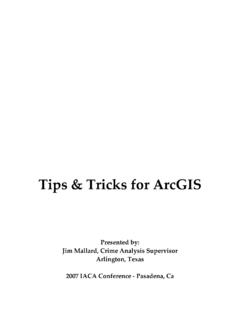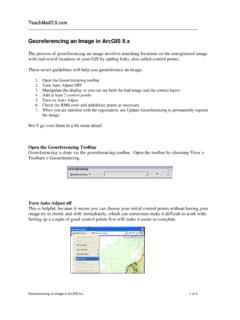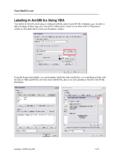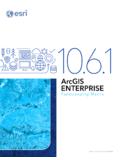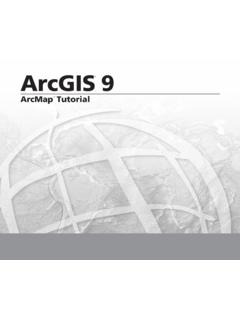Transcription of ArcGIS Datums and Transformations Quick Reference
1 ArcGIS Datums and Transformations Quick Reference May 2013 What is a Datum? Simply put, a datum is a model used for calculating the location of the Earth's center. This center calculation is used as a Reference point in establishing coordinate locations, such as latitude and longitude, on the Earth's surface. Coordinates calculated using one datum may represent a geographic location several hundred feet away from the same coordinate numbers calculated from another datum. This is because the two sets of coordinates are being measured from different Reference points. Horizontal Datums measure positions on the surface of the earth, while vertical Datums are used to measure land elevations and water depths.
2 Thus, to integrate data from multiple sources that are referenced to different Datums requires appropriate datum transformation tools. Common Datums for Hawaii Old Hawaiian Datum Old Hawaiian is a geodetic datum first defined in, and is suitable for use in, the main Hawaiian Islands. Old Hawaiian references the Clarke 1866 ellipsoid and the Greenwich prime meridian. The Old Hawaiian origin is Oahu West Base Astro; ( latitude: 21 18' "N, longitude 157 50' "W ). Old Hawaiian is a geodetic datum used for Topographic mapping. The Hawaiian Islands were never on NAD27 but rather on Old Hawaiian Datum. The NGS s NADCON conversion program provides transformation from Old Hawaiian Datum to NAD83 (1986) but making the transformation appear to user as if from NAD271.
3 North American Datum 1983 The North American Datum of 1983 (NAD 83) is "The horizontal control datum for the United States, Canada, Mexico, and Central America, based on a geocentric origin and the Geodetic Reference System 1980. It is an earth centered datum unlike its predecessors NAD27 or Old Hawaiian. NAD83 (1986) For the Hawaiian Islands, NAD83 came into use in 1986. The first NAD 83 datum is commonly called NAD 83 original or NAD83(86)2. It was determined before GPS techniques had been developed. It has a significant positional shift from the Old Hawaiian Datum of over 1,000 feet. NAD83 (HARN or HPGN) High Accuracy Reference Network (HARN) and High Precision Geodetic Network (HPGN) were two designations used for a statewide geodetic network upgrade.
4 The generic acronym HARN is now used for both HARN and HPGN and was adopted to remove the confusion arising from the use of two acronyms. HARN is a statewide or regional upgrade in accuracy of NAD 83 coordinates using Global Positioning System (GPS) observations. The cooperative network upgrading program was completed in 1997 after horizontally upgrading some 16,000 survey stations to A-order or B-order status. Horizontal A-order stations have a relative accuracy of 5 mm +/- 1:10,000,000 relative to other A-order stations. Horizontal B-order stations have a relative accuracy of 8 mm +/- 1:1,000,000 relative to other A-order and B-order stations.
5 NAD83 (PACP00) In the summer of 1993, NGS conducted an extensive GPS survey to determine positional coordinates for points on numerous islands in the Pacific Ocean. These new Reference frames were defined so as to be consistent with NAD 83 realizations at the epoch. Each of these two frames is defined in terms of a transformation from International Terrestrial Reference Frame (ITRF00). Hence, the two new spatial Reference frames one for the Pacific tectonic plate to be called NAD 83 (PACP00) and one for the Mariana tectonic plate to be called NAD 83 (MARP00) are designed so that users of these frames do not have to cope with changing positional coordinates for those positioning applications that are confined to the interior of one of tectonic plates.
6 These frames are distinct from all NAD 83 realizations. NAD83 (PA11) On September 6, 2011, NGS updated the National Spatial Reference System NAD 83 (CORS96, MARP00, PACP00) positions and velocities for all CORS sites, to NAD 83 (2011, MA11, PA11). The NAD 83 (2011) frame, which is relative to the fixed North American plate, is used to define the coordinates for sites located in the CONterminous United States (CONUS), Alaska and US territories in the Caribbean. The NAD 83 (MA11) frame is realized with respect to the fixed Marianas plate and is used to define coordinates in the Marianas. The NAD 83 (PA11) is a Pacific plate fixed frame and is used to define coordinates in Hawaii, American Samoa, the Marshall Islands and other US territories residing on the Pacific Plate NAD83(PA11) epoch the realization of the Reference frame fixed to the Pacific tectonic plate, and it consists of stations located in Hawaii and American Samoa.
7 NAD83(MA11) epoch is the realization of the Reference frame fixed to the Mariana tectonic plate, and it consists of stations located in Guam and the Commonwealth of the Northern Mariana Islands (CNMI). WGS 1984 WGS 84 is the World Geodetic System of 1984. It is the Reference frame used by the Department of Defense (DoD) and is defined by the National Geospatial-Intelligence Agency (NGA). WGS 84 is used by DoD for all its mapping, charting, surveying, and navigation needs, including its GPS. WGS 84 was defined in January 1987 using Doppler satellite surveying techniques. It was used as the Reference frame for broadcast GPS orbits beginning January 23, 1987.
8 On January 2, 1994, WGS 84 was upgraded in accuracy using GPS measurements. The formal name then became WGS 84 (G730) since the upgrade date coincided with the start of GPS Week 730. It became the Reference frame for broadcast orbits on June 28, 1994. From 1986 until 1994 the NAD83 and WGS84 Datums where considered identical. Over time, the two coordinate systems became increasingly different. On September 30, 1996 (the start of GPS Week 873), WGS 84 was redefined again and was more closely aligned with International Earth Rotation Service (IERS) Terrestrial Reference Frame (ITRF) 94. It is now formally called WGS 84 (G1150).
9 Datum Transformations Datum transformation algorithms are implemented within GIS software as well as in the post-processing software provided by GPS vendors for use with their receivers. Some transformation algorithms yield more accurate results than others. The method you choose will depend on what choices are available to you and how much accuracy your application requires. There are many ways of modeling the transformation between two Datums , but those in commonly use include Molodensky, 7-parameter and Surface Fitting. For larger study areas more accurate results may be obtained using a seven-parameter transformation that accounts for rotation as well as scaling and offset.
10 Finally, surface fitting Transformations like the NADCON grid interpolation described above yield the best results over the largest areas. The National Geodetic Survey (NGS) is the US Government agency tasked in managing and defining the National Spatial Reference System (NSRS) includes the responsibility to develop tool allowing users to transform data between different systems. Transformations to Use in ArcGIS Old Hawaiian to NAD83 NAD_1983_To_HARN_Hawaii + Old_Hawaiian_To_NAD_1983_HARN_Hawaii NAD 1983 to NAD HARN WGS_1984_(ITRF00)_To_NAD_1983 + WGS_1984_(ITRF00)_To_NAD1983_HARN NAD 1983 to NAD 1983 PACP00 WGS_1984_(ITRF00)_To_NAD_1983_HARN_PACP0 0_To_WGS_1984 NAD 1983 to NAD PA11 WGS_1984_(ITRF00)_To_NAD_1983 + WGS_1984_(ITRF08)_To_NAD_1983_PA11 NAD 1983 to Web Mercator Auxiliary Sphere (Use to optimize web mapping applications) WGS_1984_(ITRF00)_To_NAD_1983 NAD 1983 to WGS 1984 WGS_1984_(ITRF00)

